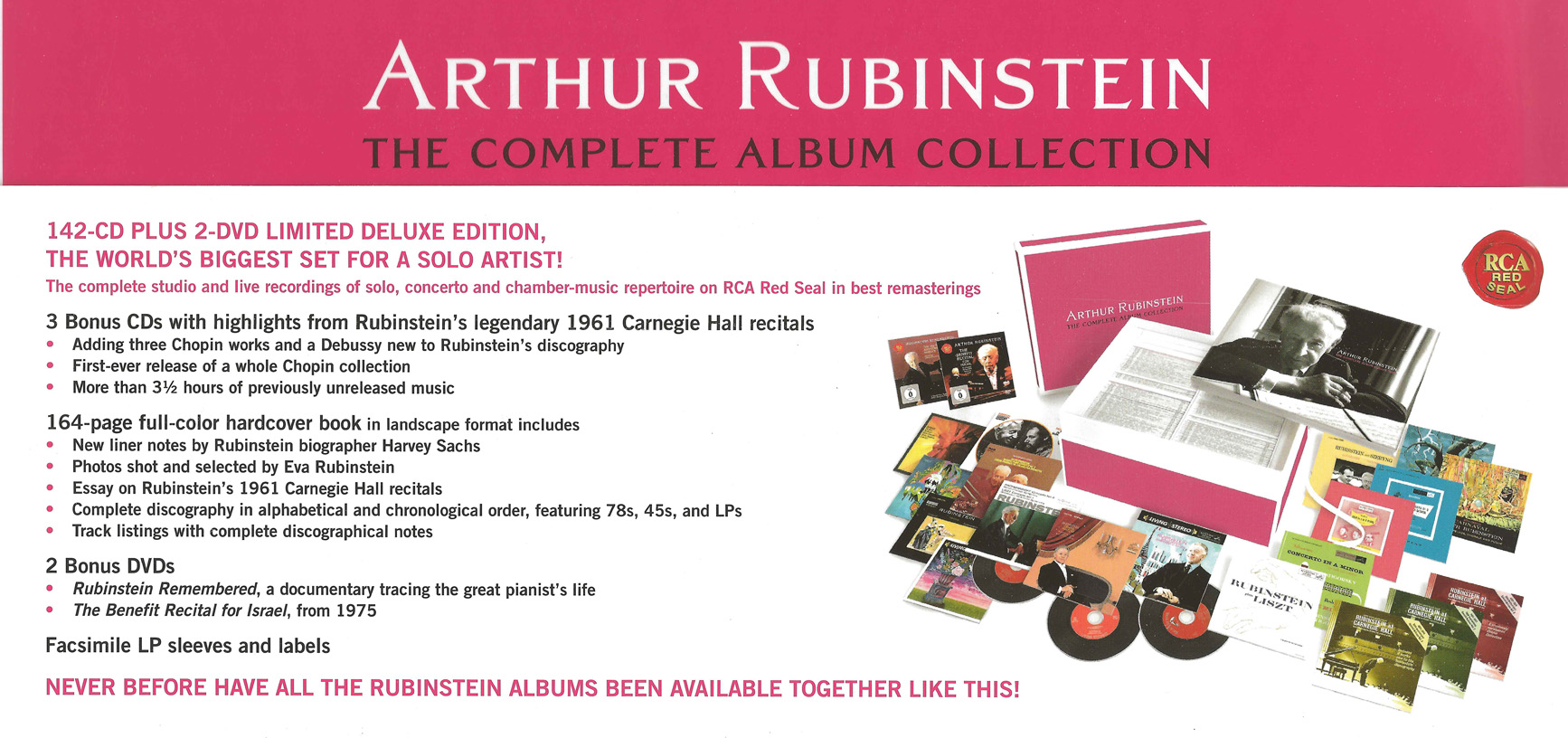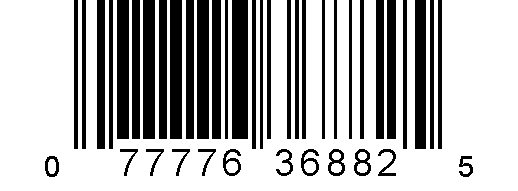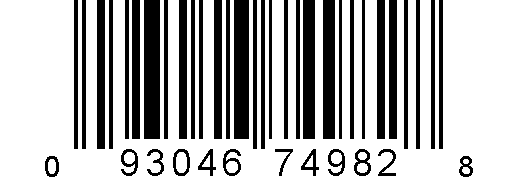Arthur Rubinstein with Piano Music by Wolfgang Amadeus Mozart,
Sergei Rachmaninoff, and Karol Szymanowski
Media Review / Listening Diary 2014-05-11
2014-05-11 — Original posting (on Blogger)
2014-11-12 — Re-posting as is (WordPress)
2015-06-09 — Added the Bezuidenhout recording for Mozart’s K.511
2016-07-21 — Brushed up for better readability
Table of Contents
Exploring the Fringes of Rubinstein’s Solo Recording Repertoire…
This posting is about solo compositions by Mozart, Rachmaninoff and Szymanowski. Yet another, very small portion in Arthur Rubinstein’s recording history, included in the recently released “Arthur Rubinstein — The Complete Album Collection“:
Wolfgang Amadeus Mozart (1756 – 1791): Rondo in A minor, K.511
The CDs
Arthur Rubinstein Collection, CD #74 (1959)
Arthur Rubinstein — The Complete Album Collection
CDs #74: Mozart: Concerto No.24 in C minor, K.491; Rondo in A minor K.511
Arthur Rubinstein
Josef Krips, RCA Victor Symphony Orchestra
SONY Classical 88691936912 (142 CDs / 2 DVDs, mono / stereo); ℗ / © 2011
Documentation 162 pp., LP liner notes on back of CD sleeve

Arthur Rubinstein Collection, CD #130 (1959)
Arthur Rubinstein — The Complete Album Collection
CD #130: Franck: Prélude, Choral & Fugue; Bach-Busoni: Chaconne; Mozart: Rondo K.511
SONY Classical 88691936912 (142 CDs / 2 DVDs, mono / stereo); ℗ / © 2011
Documentation 162 pp., LP liner notes on backside of CD sleeve

Walter Gieseking (1954)
Mozart: Complete solo piano Works
EMI Références CHS 7 63688 2 (8 CDs, mono); ℗ 1954/1990 / © 2011
Booklet 14 pp. f/e/d

Ronald Brautigam, fortepiano (1997)
Mozart: Complete Sonatas & Variations
BIS-CD-1633/36 (10 CDs, stereo); ℗ 1996-2001 / © 2006
Booklets 36 pp. (Sonatas) + 36 pp. (Variations), e/d/f

Kristian Bezuidenhout, fortepiano (2010)
Mozart: Keyboard Music, Vol. 2
(Piano Sonatas K.330 & 457; Rondos K.485 & 511; Adagio K.540)
harmonia mundi usa HMU 907498 (CD, stereo); ℗ / © 2011
Booklet 20 pp., e/f/d

Rubinstein and Mozart
In my posting “Arthur Rubinstein’s Recordings” I mentioned one duplicate recording in the collection (Beethoven, piano sonata No.18 in E♭ major, op.31/3, “The Hunt”) — I now realized that Mozart’s Rondo in A minor, K.511 is another instance: it is present on the two CDs above:
- CD #74 (track 4): duration: 10’15”
- CD #130 (track 2): duration 10’20”
As it turns out, both tracks were created from a single stereo recording at the American Academy of Arts and Letters, New York City, USA, on 1959-12-22 — but somehow, the two instances were restored from different “matrices” (the “silent trailer” in the “second recording” is five seconds longer). There may possibly be minor differences in the sound quality — but in the comparison below I’m going to treat them as one and the same.
This is the only solo piece by Mozart that Rubinstein ever recorded — for reasons similar to those used with Haydn. Mozart only knew early stages of the (forte)piano, so Rubinstein felt that playing that music on a Steinway would be inadequate. Luckily, he made exceptions for two piano quartets and five piano concerts (the concerto in A major K.488 was even recorded 3 times in the course of his artistic career!).
Other Recordings
I have additional recordings of the Rondo in A minor, K.511 in my collection:
- one with Walter Gieseking, recorded in 1954 (duration: 7’54”), as part of his complete Mozart recording (which I already had on LP, hence it found its way into my CD collection),
- another one from 1997 (duration: 9’55” without trailing silence) with Ronald Brautigam as part of his historically informed Mozart recording, played on a fortepiano by Paul McNulty (1992), after an instrument by Anton Gabriel Walter, Vienna, ca. 1795, and
- finally, one from 2010 (duration: 10’36”) with Kristian Bezuidenhout as part of his ongoing recording of Mozart’s keyboard works, played on a fortepiano by Paul McNulty, Divisov CZ (2008), after an instrument by Anton Walter & Son, Vienna, ca. 1802 (unequal temperament tuning at a’ = 430 Hz).
Comments on the Interpretations
Here are some brief notes on the three interpretations:
Walter Gieseking (1954)
Well, if there was a need for an example on how not to play this Rondo, then this would be the perfect example. I don’t know why Gieseking was ever so well-known (except for his phenomenal memory) — he played most Bach, all Mozart solo compositions, Beethoven, etc. — but I think he only really was competitive with the French impressionist composers such as Debussy.
He takes this Rondo relatively fast (3/8 = 48), maybe trying to make the Andante based on 3/8 (as one would need to with Beethoven) — but M.M. 48 is still not a proper Andante — and with the fast passages, a true 6/8 Andante (à la Beethoven) is not playable. Moreover, even at 3/8 = 48, this piece sounds incredibly superficial — plus, Gieseking often tends to let the tempo “run away”; I even sense a certain tendency to accelerate with every crescendo — a really bad habit. He does articulate / phrase fairly well in the right hand, but in the left hand, figures such as the accompaniment to the beginning of the theme sounds like the “umtata – umtata” of a cheap, fast waltz.

Overall, I think Gieseking really doesn’t do justice to this piece (a late composition by Mozart, from 1787, after all!).
Rating: 2
Arthur Rubinstein (1959)
Rubinstein plays this so much better than Gieseking! His tempo is 3/8 = 38 — substantially slower than Gieseking; and of course, Rubinstein keeps tempo control while allowing for discreet, sensible agogics; he is very careful in articulation and phrasing — I think, that’s about as good as it can be on a modern concert grand (well, Friedrich Gulda might be an interesting alternative — but he did not record this Rondo, as far as I know).

It’s hard to find a “hair in the soup” with Rubinstein — the only things I could find were the missing, simple trill in the middle of bar 15 from the end (a “baroque” feature that may be hard to do on a modern concert grand), and in the seventh bar after the return to a minor (after the central A major section), the trill in the trill chain that does not cover the last quaver — but bot these are very minor points — the interpretation is excellent, overall.
Rating: 3
Ronald Brautigam (1997)
Brautigam plays at a tempo similar to Rubinstein’s (ca. 3/8 = 39) — but that doesn’t mean much, given the profound differences in sonority and agility between the two instruments. Ronald Brautigam of course uses very “speaking” articulation and phrasing with expressive dynamics and agogics (much more than the other two interpretations above), fully exploiting the sonority of the fortepiano. I find that this instrument makes balancing the two hands easier, as the lower notes still have that bright, singing quality.

The Trio / A major part really is dolce (una corda, if I’m not mistaken), and towards the end of the A major section, those bass triplet scales develop a sonority / liveliness that is impossible to match even remotely on a modern piano. Brautigam’s interpretation is more dramatic, more expressive, never superficial, with all the depth that is needed for this composition — simply excellent!
Rating: 4
Kristian Bezuidenhout (2010)
Bezuidenhout offers the slowest interpretation, at least in the a minor part, at around 3/8 = 36 (he plays the A major part at around 3/8 = 42). I was quite overwhelmed by Brautigam’s recording when I did the original comparison a year ago, but now I see that Kristian Bezuidenhout takes this yet one level further — in various ways! For starting, already the recording technique is better, more direct, giving a much clearer “view” on the instrument’s sound characteristics (closer microphone placement?).
Articulation, Phrasing
Then, Bezuidenhout’s playing is so much more detailed in agogics and dynamics / phrasing — and more colorful: Brautigam (as far as I can hear) occasionally uses the una corda pedal, Bezuidenhout also uses the moderator, e.g., for the first (repeated) part of the A major section, which adds an interesting touch to this segment (maybe with the slight disadvantage that the distinction between legato and staccato semiquaver triplet passages is a bit blurred — but there are plenty of other instances in the piece where this can be played out). Bezuidenhout’s agogics are so incredibly well-considered and detailed — every note in every bar appears with its appropriate weight, there isn’t a single superficial interval / note — a thoroughness that somehow reminds me of Emil Gilels!
Ornamentation
Bezuidenhout also takes more freedom in adding the occasional extra ornament (in repeats or recurring motifs), and it is quite possible that the unequal temperament tuning adds extra color, too. But I don’t know about Ronald Brautigam’s tuning. Also, the fortepiano replicas that McNulty now makes in the Czech Republic (he moved there because apparently the local wood is suited better for such instruments) are better than those from the early 90’s.
In view of this recording, I had to downgrade the ratings for Rubinstein’s and Brautigam’s recordings — and I’m curious to see whether (as I suspect) Bezuidenhout outperforms his contenders in his other Mozart recordings — this interpretation is absolutely in line with the other Mozart recordings by that artist that I listened to so far (see my posts on other recordings with that artist).
Rating: 5
Sergei Rachmaninoff (1873 – 1943): Prélude in C♯ minor, op.3/2
The CDs
Arthur Rubinstein Collection, CDs #6 – 10
Arthur Rubinstein — The Complete Album Collection
CDs #6 – 10: The Early Recordings 1931 – 1939
SONY Classical 88691936912 (142 CDs / 2 DVDs, mono / stereo); ℗ / © 2011
Documentation 162 pp., track listing on CD sleeve

Arthur Rubinstein Collection, CD #32
Arthur Rubinstein — The Complete Album Collection
CD #32: Rubinstein Encores
SONY Classical 88691936912 (142 CDs / 2 DVDs, mono / stereo); ℗ / © 2011
Documentation 162 pp.; LP liner notes on back of CD sleeve

Rubinstein’s Only Recorded Solo Rachmaninoff
Arthur Rubinstein’s Rachmaninoff recordings (as covered by the “Complete Album Collection”) include two instances of the Rhapsody on a Theme by Paganini, op.43, and three instances of the Piano concerto No.2 in C minor, op.18 — but only one single piece for piano solo, the second piece from the “Morceaux de fantaisie” op.3, the Prélude in C♯ minor, op.3/2, which Rubinstein probably used as an encore. This is a nice, calm piece (not virtuosic at all) — it somehow reminds me of Claude Debussy’s Prélude No.10 from the first book, “La Cathédrale engloutie”, even though clearly, Rachmaninoff’s piece is late romantic, while Debussy’s is impressionist, using a much wider tonality.
The “Complete Album Collection” includes two instances of this Prélude:
- a recording from 1936 (mono, from 78 records) — duration: 4’24”
- a second recording from 1950, also mono, produced for LP — duration: 4’17”
Interpretation(s)
Interestingly, this is an example that demonstrates that “newer” isn’t always better! Sore, the first recording is lacking the high frequencies from the suppression of the hiss and crackling. It sounds a bit dull — but apart from that, the piano sound is round, warm, full — a very nicely restored track!
14 years later, the recording technique has improved, there was less of a need to suppress high frequency noise — however, from all I can tell, that Steinway (I think Rubinstein always played Steinway) must have been in terrible shape and really calls for a thorough intonation (the tuning may be OK, but the hammer-heads are in bad shape, and I’m sure this is not a question of the microphone placement): when played f and louder, the higher strings are sounding metallic, if not twanging — and also musically, there is no reason to prefer this recording (the two interpretations are fairly close, as far as I can tell). Overall: I really prefer the recording from 1936!
Karol Szymanowski (1882 – 1937): Mazurkas op.50
The CDs
Arthur Rubinstein Collection, CDs #11 – 14
Arthur Rubinstein — The Complete Album Collection
CDs #11 – 14: The Early Recordings 1938 – 1949
SONY Classical 88691936912 (142 CDs / 2 DVDs, mono / stereo); ℗ / © 2011
Documentation 162 pp., track listing on CD sleeve

Arthur Rubinstein Collection, CD #78
Arthur Rubinstein — The Complete Album Collection
CD #78: Rubinstein at Carnegie Hall
Debussy: 4 pieces; Szymanowski: 4 Mazurkas; Prokofiev: Visions fugitives; Villa-Lobos: 6 pieces from “Prole do bebê Nr.1”
Arthur Rubinstein
SONY Classical 88691936912 (142 CDs / 2 DVDs, mono / stereo); ℗ / © 2011
Documentation 162 pp., track listing on CD sleeve

Karol Szymanowski in Rubinstein’s Repertoire
Apart from a recording of the fourth Symphony (“Symphonie concertante“) for piano and orchestra op.60 by Karol Szymanowski (1882 – 1937), Rubinstein only officially recorded a selection of four of the 20 Mazurkas op.50 by that composer, back in 1946 (Nos.1, 2, 3, and 4, for 78 r.p.m. disks). He must have kept playing Szymanowski’s Mazurkas in concerts, but did apparently not see a need for a re-recording for newer media / better recording technique. However, we have a live recording (stereo, with much better sound) from Carnegie Hall, from 1961, where he played Nos. 1 – 3 again, but substituted No.6 for No.4:
- Sostenuto, molto rubato: duration 2’00” (1946) — 2’03” (1961)
- Allegramente, poco vivace, Rubasznie: duration 1’53” (1946) — 2’00” (1961)
- Moderato: duration 2’05” (1946) — 2’26” (1961)
- Allegramente, risoluto: duration 2’19” (1946)
- Vivace: duration 1’53” (1961)
Interpretation
Rubinstein’s interpretation hasn’t changed that dramatically in the 15 years between these two recordings: the first, calm, quiet Mazurka is almost identical in length; in the more vivid Mazurkas 2 and 3, the early recording was somewhat more extroverted, while at Carnegie Hall (at the age of 74!) he seemed more focused on good articulation, clarity and transparency (which of course is also supported by the far better recording technique). We don’t have records how No.4 would have sounded in 1961, or how No.6 would have sounded in 1946, but one can see that the remarks on Mazurkas 2 and 3 would apply as well.
A pity that Rubinstein did not record all of Szymanowski’s Mazurkas! These are nice, still fairly tonal pieces — excellent, short and entertaining compositions (just don’t expect music in the style of Chopin’s Mazurkas!!), well worth listening to!
Listening Diary Posts, Overview
















